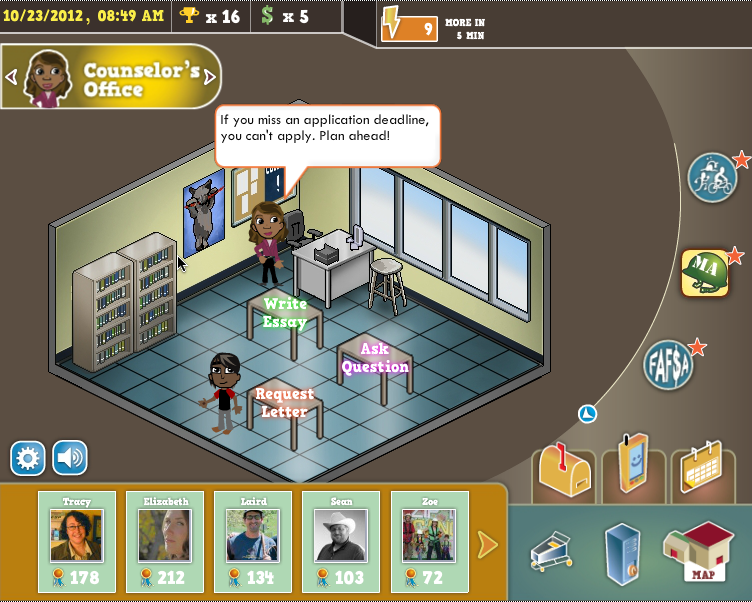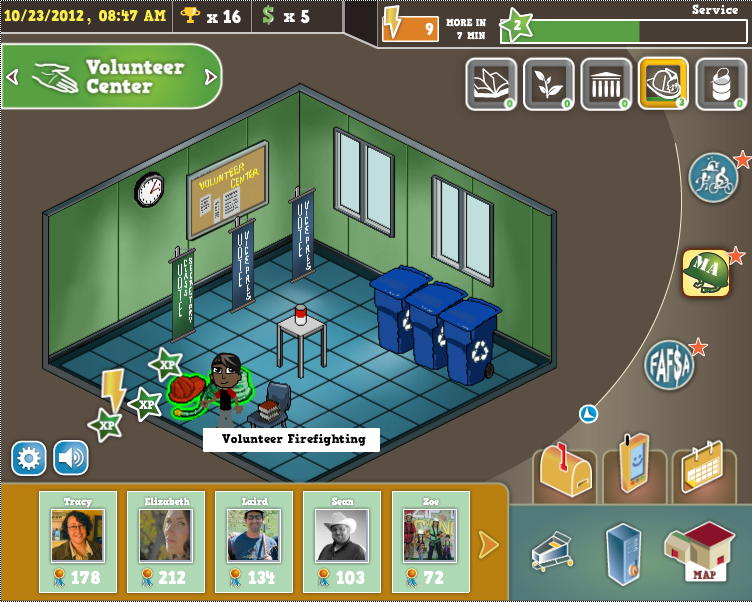Can a Game Help Low-Income Youth Get into College?: An Interview with Colleagology Games (Part Two)
/ Mission: Admission represents an attempt to translate your earlier game into Facebook. What differs between the two versions? What has social media allowed you to do which you couldn’t do before?
Mission: Admission represents an attempt to translate your earlier game into Facebook. What differs between the two versions? What has social media allowed you to do which you couldn’t do before?
TF: Mission: Admission is a Facebook adaptation of Application Crunch. Like the card game, it is about the application process. In the game, you take on a character that is applying to college. That character has a family financial background and an aspiration about what they want to be in life. The game takes place over a real world week, driven by a set of deadlines that are similar to those in the card game: applications for colleges, scholarships, FAFSA, etc.
Because it is a digital game, we can bring the game to life a bit more in this format. So, the game takes place in a school where activities that you can engage with are found in the various areas: the library, the counseling office, the fine arts studio, the gym, the tech lab, the writing lab, etc.
When you start out, your school only has a few activities available, so your character doesn’t have as much opportunity as you might like. We meant this to be representative of how many low income students might experience their schools.
As you help your character earn scholarships, get accepted to schools, and more, you earn “pride” for your school, which you can spend upgrading the various areas to include more options for your character. At the end of each week, your character goes off to school, if you were successful in getting them accepted and finding ways to pay for the college of your choice.
You get a new character to help, and your former characters will write you letters home telling you how they are doing in school. Overall, it is a much deeper system in many ways, than the card game, but I think they both have their strengths.
Some may wonder about your decisions regarding the duration of game play on Mission: Admission. Can you explain your rationale for having such a prolonged play experience?
TF: It’s an interesting question—especially when you think of how long people play games like Farmville. In truth, I think the real difference is that we have made a game with a fixed time cycle, rather than the kind of open-endedness that most Facebook games employee. This was dictated somewhat by our subject matter: the college application process has a fixed duration and then you go or you don’t go to college.
We could have chosen to make a shorter game, of course, like a casual game that took, like 10-20 minutes to play through the application process. If we had done this, however, we would have lost what we thought of as a key learning: that you need to keep these deadlines in mind while you’re going on with the rest of life.
When you play the Facebook game, you can only make so many moves per session before you use all your energy. Then, you need to wait and remember to come back to finish your applications.
You also need to plan ahead. For example, many applications require letters of recommendation. These take time so you need to request them at least 12 hours before an application is due—time in the game is abstracted, as is money. You might have everything you need to apply to a full ride scholarship that will let you go to the college of your dreams, but if you don’t get that last letter of recommendation in on time, all your plans will dissipate. That is a pretty important lesson to learn!
ZBC: It’s one thing to teach students information about college, it’s another thing to teach them strategies. The weeklong play session exposes first generation students to valuable “life” lessons.
Chances are that college-educated parents who are familiar with the complexity of college applications will nudge their child to ask for letters of recommendation early, participate in an extracurricular or volunteer activity, or make sure to stay on top of deadlines. Many low-income students do not have that kind of targeted support at home or in their schools. Mission: Admission’s weeklong play time cultivates in college-related cultural capital.
What can you tell us about the balance between competition and collaboration in terms of the ways high school students engage with your games?
TF: The games are really about competing with the system and not directly with each other. Of course, there is competition—sometimes fierce—to be accepted at the more selective colleges, or for scholarships, but we find there is a lot of collaboration between players as well.
Both Application Crunch and Mission: Admission have an “ask a question” feature which rewards both the person who asks the question and the person who answers it best. These questions tend to create an atmosphere of safe discussion around college topics, where students can share what they know, or what they’ve learned from playing.
Also, as I’ve already noted, students like to share their strategies for play. We see that those who’ve played before like to teach new players the ropes. This confidence in their own understanding of the process is a real win for us, and seeing them share this understanding with fellow students in a kind of peer mentoring is really exciting.
What aspects of the game do they seem to bring with them back to their real world educational experiences?
TF: The things we see them bringing to their second plays are vocabulary (FAFSA, letters of recommendation, etc.) and strategy (safety schools, time management, meeting deadlines, etc.). Also, they bring a heightened sense of efficacy back, as found by our research team.
The project is too early on to see how strongly this transfers to their real world application processes, but we would love to be able to follow our current test group to see how that plays out.
ZBC: Many times we meet with students who are invested in going to college but don’t know what questions to ask adults who could serve in an advisory capacity. The games often act as a catalyst for generating conversation among students and adults. While students are playing, they frequently ask questions with real-life applications to the teacher or advisor in the room.
You are now turning your attention to developing a game for middle school students. What different kinds of goals and expectations are informing this project? What do elementary school students need to know about college?
TF: The middle school game is a very different kind of game. First, it is not directly about college or the application process. Instead, it focuses on the “adventure” of middle school, a place filled with monsters created by fears and doubts. In this game, it is the development of your interests into passions and skills that give you the power to defeat those monsters and make your way through middle school.
As with the high school games, we worked with a “junior design team” of local middle school students to create the game. The designers spent a lot of time teasing out what kinds of understanding—or misunderstandings—the students had about college and careers. As it turned out, they had almost no idea about what college is, how you get there, and what it might have to do with your future career.
We didn’t want to make a game explaining all of that, but we did want kids to feel like the choices they make now, in middle school, will affect the opportunities they have as they move into high school, college and career. The best weapons they can have in their journey are their own passions and skills. So, we created a game where those passions and skills turn into powers that help them fight through the demons of middle school.
Along the way, they are scaffolded in other ways: making friends who have high ambitions, starting and participating in clubs about their interests, seeking out mentors and other “soft skills” that may help them along the way. In the end, it is really a game about exploring and keeping your options open.
What did you gain by developing these games in the context of a major research university as opposed to through a commercial game or ed-tech company?
TF: The partnership between the Game Innovation Lab and The Pullias Center for Higher Education is a critical part of how these games are being developed. The fact that we’ve had access to our target players from day one is invaluable, as is the insight into the concerns of teachers and counselors.
The research we’re doing to evaluate these games is something that would never have happened if we had developed them in a commercial setting. I also believe that the opportunity to develop the kind of deep systemic mapping between the real world “mechanics” of the application process and the game mechanics would not have happened in another setting.
These games are built to allow players to develop the kind of strategies they can transfer to the real world. A player who walks away thinking: “I really should take pre-algebra in middle school,” or “I should remember to turn in my FAFSA,” are taking away something real from playing these games.
ZBC: Besides working with students as an integral part of the design and playtesting process, we also work closely with teachers, counselors and practitioners to learn from them how to best implement the games and to gather and verify ideas for content.
Tracy Fullerton, M.F.A., is an experimental game designer, professor and director of the Game Innovation Lab at the USC School of Cinematic Arts where she holds the Electronic Arts Endowed Chair in Interactive Entertainment. The USC Game Innovation Lab is a design research center that has produced several of the most influential projects to be released in the emerging field of independent games, including games like Cloud, flOw, Darfur is Dying, The Misadventures of P.B. Winterbottom, and The Night Journey -- a collaboration with media artist Bill Viola. Tracy is also the author of “Game Design Workshop: A Playcentric Approach to Creating Innovative Games,” a design textbook in use at game programs worldwide. Prior to entering academia, she was a professional game designer and entrepreneur making games for companies including Microsoft, Sony, MTV, among many others.


